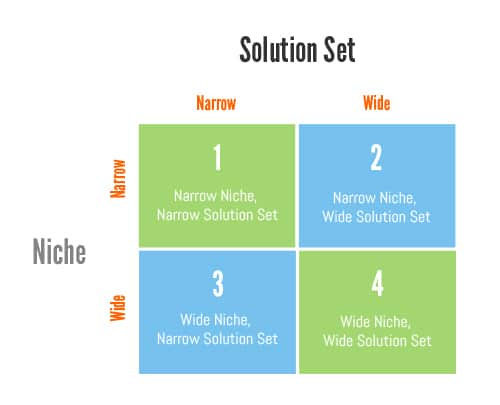Entrepreneurs, executives, and small business owners are often advised to focus their businesses, but that usually comes down to being told to focus on a niche. There are at least two dimensions of business focus a business can have, though: niche and solution set. And a business can have a wide or narrow focus on each of those, so we get the following 2x2 grid:
The Two Dimensions of Focus
So we're all on the same sheet here, a niche is a distinct group (segment) of people in a market. A solution set is a particular service, product, or domain expertise that a business provides — few businesses just have one product, so set is more accurate.
A business that sells decorative cages to parakeet owners is on the extreme side of Quadrant 1 with a narrow niche and a narrow solution set. Nike is currently in Quadrant 4, selling a little bit of everything to everyone, but it started in Quadrant 1 selling tennis shoes for athletes.
Follow the general rule of looking at 2x2 grids and see it more as an axis overlay than black-and-white boxes. A business that sells decorative cages to bird owners is still in Quadrant 1, but just not as far to the left and up as the business that's niched for parakeet owners. In that same way, "athletes" is a pretty wide niche, but it's still niche enough that you can focus on specific psychographic trends of that niche.
Most entrepreneurs come out of the gate wanting to be in Quadrant 4, but the reality is that most businesses should start in Quadrant 1 or 2 mostly because it's easier to focus your marketing on certain people than it is to figure out all of the different ways you can sell a narrow solution set to a wide group of people.
Applying the Framework
I was talking about this framework on the last Monthly Momentum Call with Julie, who's starting a business that makes custom bras for women. There are a lot of women who simply can't find a mass-produced bra that fits them correctly because breasts don't fit neatly into 9 or 10 uniform sizes. Couple that with the fact that it's normal for one of a woman's breasts to be bigger than the other and you have a fairly common problem that isn't being served by mass-market solutions.
Custom bras as a solution set is pretty narrow, so that puts her in either Quadrant 1 or 3. Julie has several options here when it comes to how to focus on a niche. She could focus on all women who can't find a bra that fits them, or she could pick an edge — say women with small breasts or women with large breasts. My counsel was to pick an edge and go with women with large breasts.
Why? Because of human trends around increasing breast size and also because it's easier to market to frustrated women with large breasts who can't find a bra that fits them than all frustrated women who can't find a bra that fits them. Think about the messaging, images, brand cues, etc. between the two alternatives, specifically thinking in terms of models Julie might use. Aside from marketing, it's probably easier to get more efficient at making bras for larger breasts (exclusively) than having to alternate between a wide variety of sizes. Julie the Craftswoman might like the variety of making a wide variety of sizes, but Julie the Entrepreneur would be better served by focusing on one edge.
Handmade, custom-fit bras for large-breasted women who can't find mass-market bras that fit them is a fairly narrow solution set and a narrow niche. She's well within Quadrant 1.
"But isn't that too focused of a business?" you may be asking. She may hit a ceiling around Stage 3 in her business, but she's not there yet. Better to start with a beachhead offer that she can build some marketing momentum around than to be too scattered and not get the lift she needs. As her business grows, she can always move down toward Quadrant 3 and be more inclusive of all women, but it's a lot better to do that once she has one particular segment dialed in. (If all this this talk of stages interests you, check out my book, The Small Business Life Cycle, that discusses small business growth patterns and how to navigate them.)
In my experience, most small and micro-businesses can thrive quite well in Quadrants 2 and 3. Quadrant 1 tends to be too focused for many Creative Giants and they get bored, and Quadrant 4 tends to create too much scattered effort for a small and micro business to be able to really grow into.
Where to Start: Niche or Solution Set?
Once you pick the quadrant you're going to be in, then you can focus even more on your Unique Selling Proposition within the space. If it's a crowded space, you'll need to differentiate more than if it's a fairly wide-open space. At some point, you'll have to differentiate — successful businesses create competitors — but focus less on competition than on finding better ways to serve your market.
If you're not sure whether to focus on the solution set axis or the niche axis, default to the niche axis — it's simply easier to focus on serving one particular set of people and figure out what additional solutions they need as you go than to keep making solutions that may not be really reaching the people you're trying to serve.
Want to dive deeper into building a focused, thriving business? Check out our Curated Posts for Entrepreneurs, where you'll find insights and actionable advice to help you navigate your entrepreneurial journey with clarity and confidence.






